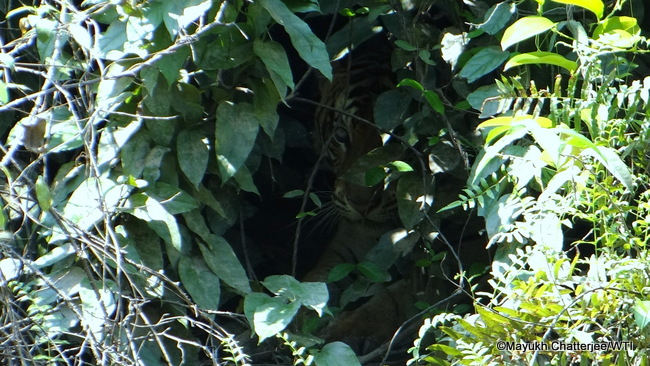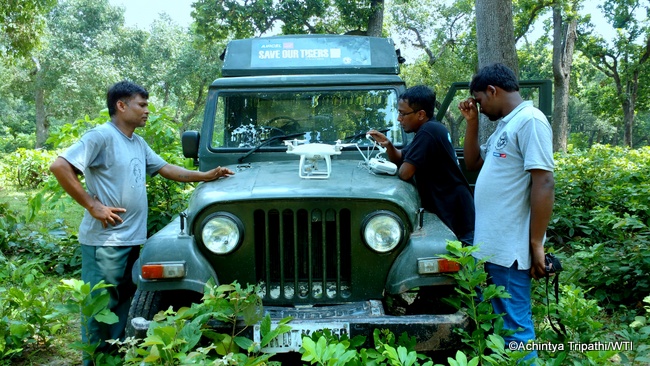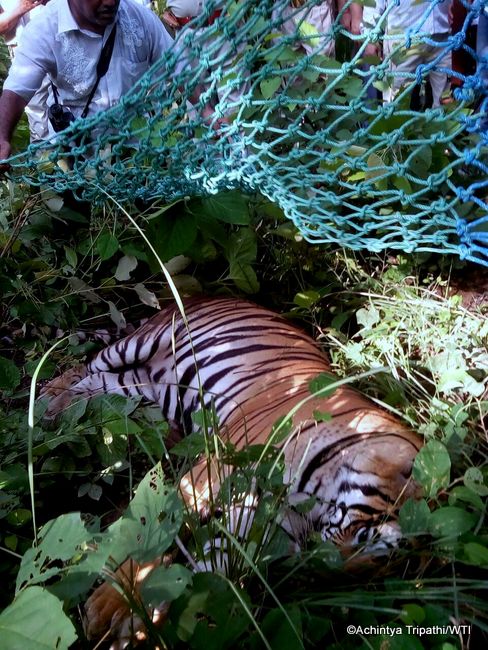The Man-eater of Mailani
By Achintya Tripathi
The forest fringe at Chedipur where the tiger was known to prowl
The true seriousness of conflict between humans and wild tigers dawned on me only when the first human-tiger conflict scenario I have ever witnessed came to a close.
I saw how big and formidable the tiger was, how capable, even when completely sedated, of inciting awe and fear in the hundreds of people that surrounded it. I finally got a sense of the damage it could inflict, indeed the damage it had already inflicted over the past few months. Even when it was completely hidden from public view, in a closed transportation crate being driven along the Gola-Khuttar highway towards Lucknow, thousands of local people thronged the route for almost 10 to 12 km, hoping to catch a glimpse of the beast or even just some gossip about its capture. That is how magnificent a tiger is; that is its immense hold on the human imagination.
Saturday Night Fever
For me it all began on the afternoon of Saturday, August 27. After a long journey by train from Delhi to Shahjehanpur and by bus on to Khuttar, I had just reached the forest rest house at the South Kheri Forest Divison, Mailani Range, Uttar Pradesh.
On the train, half-dozing as I looked out of the window, I had dwelt on some of the shocking updates I had received on the ongoing situation. Three people had been attacked and killed, the last of these partially eaten, by a tiger between August 15 and 20. Another four deaths had previously been recorded in the same forest division since February, though these could not be unambiguously linked to the same tiger. Some reports had said that this tiger was fearless, that it would hold its ground even when faced with a mob of angry humans. To my excited mind it was morphing into something much more formidable than an ordinary wild tiger. Was it truly a man-eater, I wondered. And if it were, how difficult would it prove to catch?
 The tiger seen through the bushes during the capture attempt on August 29
The tiger seen through the bushes during the capture attempt on August 29
There were a lot of vehicles parked outside the Mailani rest house. Judging by their blue strobe lights I gathered that senior officials of the Forest Department had convened for a discussion on the issue. No sooner had I alighted than a small crowd of people poured out of the rest house and hurriedly got into their vehicles and rushed off. I jumped right back into the jeep with my colleague Karam Singh and we joined the convoy.
A half hour later we passed through a village where a massive crowd of villagers had gathered. This, Karam Singh told me, was Chedipur – where the last two killings had occurred. We stopped at the edge of the jungles of the Mailani range, just outside the village. I joined the rest of the Wildlife Trust of India (WTI) team which had rolled up in another vehicle.
Consisting of local volunteers from a village or villages experiencing a high frequency of conflict with big cat species, PRTs typically help to prevent unruly crowds from forming during a conflict or rescue situation.
Over the next hour the team explained the situation to some very senior Forest Department officials and planned the way forward. Then the entire bandwagon again rushed back to the Mailani rest house to continue the meeting. By evening, ‘Operation Mailani’ was on. Senior officials had named the tiger ‘Chedilal’, after Chedipur village. I was told that our team would work on three strategies simultaneously: locating the tiger and monitoring its movements; pacifying the local villagers and building support for the operation; and if an opportune moment struck, capturing the tiger.
The team had, in fact, already begun working with the villagers and had constituted what is called a Primary Response Team (PRT). Consisting of local volunteers from a village or villages experiencing a high frequency of conflict with big cat species, these PRTs typically help to prevent unruly crowds from forming during a conflict or rescue situation. They also educate other villagers on the precautionary measures to be taken in order to avoid confrontation with potentially dangerous wild animals, and help share local information quickly with the relevant authorities as well as the WTI team. With additional training they can help with the identification of signs such as pugmarks, patrolling and first aid.
At 4.00am the next day I was jolted out of sleep by my colleague Dr Mayukh Chatterjee, who heads WTI’s UP Big Cat Conflict Mitigation Project. Dr Aaron Wesly, the project’s veterinarian, Prem Chandra Pandey (Pandey ji), the team’s sociologist and Karam Singh (described to me as “the most important member of the team”) slowly emerged from other rooms and we quickly headed out to the same forest fringe where we had been the previous evening.
A team from Lucknow Zoo came to the spot shortly thereafter. While they went into the forest on elephant back, tranquiliser guns at the ready, we headed along the forest edge, first scouting the area remotely using quadcopters then looking for signs of the tiger’s presence on foot. Although I’ve been blessed with several vehicle-mounted sightings of tigers in different parts of the country, this was so much more exciting because I had never encountered a tiger on foot – and this was a potential man-eater!
Mayukh and I took readings wherever we spotted pugmarks and other signs. A trap cage was also deployed, along with two buffalo calves tied to pegs, to lure and localise the prowling tiger. We then headed back to Chedipur and met the PRT members as well as several Forest Department personnel who were camping in the village. After a couple of hours we headed back to our camp.
 WTI’s MVS team prepares a quadcopter drone
WTI’s MVS team prepares a quadcopter drone
The next morning, August 29, we made another early start. We had just finished our morning rounds and were deploying our camera traps when we got a very ‘confident’ report of a tiger sighting. We rushed to the spot, at the Terhwa Bridge just about 100 metres south of the Gola-Khuttar highway. I was very excited, but after several hours of scouting no one was able to locate the tiger. A host of suggestions began pouring in from the local people who had gathered there in large numbers; some said the tiger was still there, while some spoke of having seen it walk into the paddy fields adjoining the area.
Then suddenly, at about 1:30pm, the tiger was spotted sitting in a thick bush growing on the banks of the narrow but deep stream that flowed beneath the bridge! A quadcopter that had been flown directly above the bridge had got the tiger curious enough to peep out of a small opening. Seeing several people it retreated, but it was quite visible through this opening.
Once the news spread that the tiger had been spotted, all hell broke loose. Although the police had been mobilised by the Field Director of Dudhwa National Park and the Divisional Forest Officer of South Kheri, and the local villagers had been moved back, everyone who was present in the area intermittently approached the tiger’s hiding spot in groups to take pictures! Our team assembled at a distance and set about planning the next step.
The camera trap pictures gathered by another conservation organisation had suggested the tiger to be an adult female that had moved out of Kishanpur WLS. A team from this organisation informed us that the tiger in the bush was indeed the same adult female, and we could attempt to tranquilise it. By now captive elephants had also been brought in, but tranquilisation attempts could not be initiated – the tiger could easily roll off into the water from where it was sitting and drown under sedation. Attempts were made to flush it out of the bush with the help of the elephants, but incredibly it did not budge. Soon the sun set, and lookouts posted on the road saw it heading back towards Chedipur under cover of darkness.
We drove back to the camp, outwitted and tired out by the tiger. I asked my colleague Mayukh why it had not even roared or charged at the elephants despite ruckus they were creating around it. There could be a number of possibilities, he explained: the tiger could be injured or maimed, or even just extremely timid by nature. Or perhaps it had simply had a bad experience with a wild elephant! With all these possibilities swimming around in my head, I dozed off in the cool night breeze and that blew in through the jeep’s window.
Chedilal’s Last Stand
I woke late the next day to find the team had left without me. When they got back I learned that there had been no news of the tiger’s whereabouts. No buffalo bait had been taken, no camera traps had been triggered; no one had seen even a pugmark. The day went by slowly, allowing me to catch up on my sleep.
We were out on our evening rounds when we received news that the tiger had attacked another human, barely half a kilometre north of the Terhwa Bridge. A migrant wage labourer working alone in one of the paddy fields had been dragged into the adjoining dense sugarcane crop at around 5:10pm.
We rushed to the area in a flash but stopped our vehicle several hundred metres from the site of the incident. We had received urgent calls from the PRT members in Chedipur that the situation was now out of hand. They reported that as the man’s corpse had been recovered with the help of captive elephants, a huge crowd from three adjoining villages had amassed and begun mobbing Forest Department and Police personnel.
Minutes later we witnessed a mass of people marching slowly towards the road. The ominous rumble of concerted slogan shouting reached my ears and a violent protest soon erupted, with rocks and stones being hurled at vehicles parked nearby. We rushed back to the Mailani rest house and convened with the concerned officials. The situation had taken a turn for the worse and new strategies needed to be framed, quickly.
Late into the night there was a frantic issuing of official letters, filing of case reports, delegation of responsibilities. About 250 kilometres away in Lucknow the news of this new death had created a frenzy as well; Chedilal was hastily declared a man-eater by higher-ups and hunters were issued permission to eliminate the tiger. Interestingly, it chose to have beef for dinner that night, pulling down one of the buffalo calves tied as bait, dragging it into the forest.
We were up and raring to go at 4.00am. Rain, and the news that Chedipur was too volatile for us to get to without heavy police support, dampened all plans. News also came in that another contingent of senior officials from the Forest Department had departed from Lucknow to directly handle the situation, and that professional hunters would be arriving the next day.
As this contingent from Lucknow arrived I expected more meetings of a serious nature to ensue. Surprisingly this was one of the shortest meetings I had attended thus far. In a last ditch effort to save the tiger’s life, our team and the team from Lucknow Zoo were requested to attempt to tranquilise it. The senior officials mobilised the local police force and at 1:00pm and we drove down in a convoy. My colleagues began their preparations in the MVS vehicle. Aaron prepared six tranquiliser darts, Mayukh issued detailed instructions to all of us, and Pandey ji was on the phone accumulating as much information as possible.
Two teams on elephant back headed into the fringe forests near Chedipur – Mayukh and Pandey ji on one elephant, Lucknow Zoo’s Dr Shukla and his assistant on the other. As they disappeared into the dense forest I kept busy by bringing the transportation crate to the site on a tractor, ensuring that police were repeatedly instructed to keep local people at bay, and taking pictures and videos to document the operation.
As I waited, my ears and eyes strained towards the forest and I became oblivious to the heat and humidity. Was that a roar? Had the tiger run away? What if it came dashing towards us? I bet everyone had the same questions running through their minds as there was pin-drop silence among us. Then I heard one of the tranquiliser guns being fired, and the shouting of the mahouts, and the sound of another dart being fired. Had the tiger been caught? After several minutes of waiting, the news arrived: it had been successfully tranquilised.
A net being placed over the sedated tiger
A Leap of Survival
As Chedilal sat quietly inside the crate moving inexorably towards a life in Lucknow Zoo, I recalled some of my earlier musings. He – for he was a male, contrary to what the camera trap photos from Kishanpur had suggested, and a relatively young male based on his sparkling white teeth – was indeed maimed, with one broken upper canine and a severe cataract in his right eye. It now dawned on me why he had been forced to hunt outside the forest, why he seemed so reluctant to charge at elephants. Mayukh had fired the two darts at Chedilal and told me that at one point during the tranquilisation attempt the tiger had come out of the thicket and walked close to the elephant, with what was seemingly just curiosity. His behaviour apparently was extremely timideven when he was hit by the darts.
For me the story was now crystal clear. Here was a young male tiger that been beaten down by the harshness of life in the wild. A fight with another tiger had probably resulted in the broken canine. His blurry vision due to the cataract had robbed him of depth perception. How could he hunt normal prey with such impairments? Hunger drives survival though, and he soon found cows and buffaloes with poor anti-predator instincts. He could eat well again. He was in good health; his body weight of 235kg suggested that he had perhaps been thriving on livestock for some time. And then? Perhaps as his blindness increased he was forced to regard a smaller, weaker creature – a human – as food, thinking it to be an easy morsel. He took the leap that survival demanded of him, but was eventually captured.
Chedilal at the Lucknow Zoo
We’ll never know if Chedilal was a seasoned man-eater, but it is probably true that he could have killed several more humans, running amok in human-dominated landscapes outside the forest as he was. Would death have been preferable to years of captivity at Lucknow Zoo? I’d like to think not. I do believe that by capturing him, in some way, we have met the needs of both animal and humans; we have adhered to the ancient Indian tradition of live and let live.
The author is Project Officer, Enforcement Assistance & Law, Wildlife Trust of India

 The tiger seen through the bushes during the capture attempt on August 29
The tiger seen through the bushes during the capture attempt on August 29 WTI’s MVS team prepares a quadcopter drone
WTI’s MVS team prepares a quadcopter drone